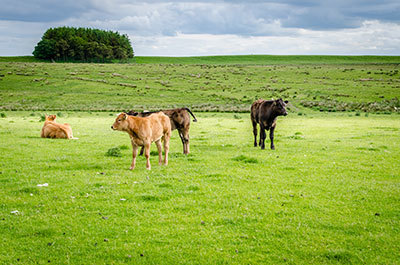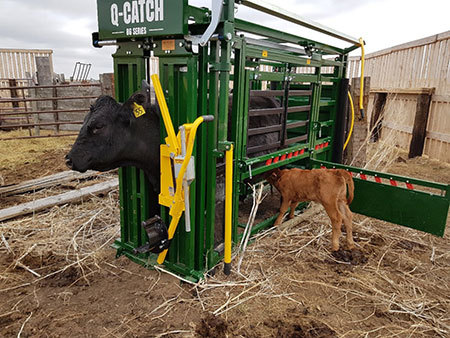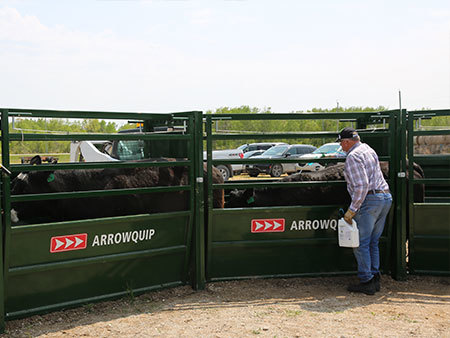5 Ways To Make Your Whole Herd Healthier
Planning Vaccinations and Deworming for Stronger Cattle Growth
Go Back to All BlogsPosted on: December 12, 2025
Updated on: December 16, 2025
Author: Liane Carter
SHARE:
Having a healthy herd can benefit your operation in numerous ways. Investing in management practices that boost your herd's health can be the change you need to take your operation to the next level. Here are five ways you can make your whole cattle herd healthier, without drastic management changes or significant financial investments.

1. Incorporate routine herd checks into your management plan.
Time is valuable, but so is your herd. Routine herd checks can spot problems before they become issues. During a routine herd check you'll become familiar with your cattle, their behavior, and normal habits. This will help you notice when something isn't quite right, and may help you spot an animal who isn't feeling well, has been injured, or is getting ready to calve.
Everyone has his or her own routine and preferences for herd check. The type and size of your operation may dictate how herd check is done, by whom, and how often. The most important aspects of herd checks are:
Take your time; if you're rushing through herd check, it won't be useful.
Be consistent. The same person should complete the herd check at a similar time/times every day. Consistency is key to establishing behavior patterns and learning about your animals.
2. Consult professionals.
Establish working relationships with your veterinarian, animal nutritionist, Cooperative Extension agent, and other professionals. These people have unique skills and knowledge that can assist you with your herd and operation. It does cost money to work with a veterinarian and nutritionist, but the return on investment quickly pays for the initial investment as your herd health improves, creating stronger growth rates and better reproductive results.
Cooperative Extension agents are a wealth of knowledge, and offer resources free of charge. If they don't have the information that you need, they can help find the right resources for you. Many offer email newsletters, fact sheets, and other information that you can read on your own, or review as needed.

3. Make a plan.
Whether it's deworming, vaccination, calving, or anything in between, you should have a plan. It is unavoidable for the unexpected to happen when calving, grazing, or dealing with some other cattle operation logistics that are out of our control. However, having a plan will help you maintain order and continuity, and be better prepared for the unexpected. A plan for deworming and vaccination can save money over the long-term as cattle are dewormed or vaccinated as needed, instead of getting excess medication that is not required. On the other hand, if you're deworming and vaccinating with a plan, cattle are less likely to become ill, or be infested with worms, and that also improves growth and saves money over time.
Veterinarians agree that vaccination is the simplest and most effective step you can take to improve your herd health. Many diseases that effect cattle and decrease performance could easily be avoided through an appropriate vaccination plan that is implemented correctly. Cow-calf operations should ensure that vaccination occurs. An investment in vaccination will pay off in weaning weights and sale prices.

4. Care for calves.
Calves are the future of your operation, and the utmost care should be given in the first few hours of their lives to ensure a healthy future. Good calf care ensures that calves receive adequate colostrum, are being mothered, do not get chilled, and are better equipped to combat scours or pneumonia. Calf care is always imperative, but the first few hours of life set the tone for future growth and development. Focusing on improving newborn calf care on a cattle operation can positively impact the next months and years of your herd.

5. Implement biosecurity practices.
There are many biosecurity threats to the health and well-being of our cattle. Contamination from wildlife, introducing new animals into the herd, mixing sick and healthy cattle, not cleaning facilities, and visitors from other herds can all introduce disease to a cattle operation. This quickly derails health, growth, and productivity.
Implementing biosecurity practices will reduce the risk of outside threats from negatively impacting your operation, and ensure a healthier herd overall. Simple steps to improve biosecurity include: keeping wildlife away from cattle, especially water and feed sources; maintaining a closed herd, limiting visitors, separating sick animals, and appropriately disinfecting human clothing and cattle facilities after caring for sick animals.
A healthy herd is a happy herd, and a happy herd is a productive herd. Improving the health of your whole herd doesn't need to be drastic or complicated. Simple changes that are consistently implemented can have dramatic effects.
Preventative measures for Herd Health
References
Beef Herd Health: Penn State Extension
https://extension.psu.edu/beef-herd-health
Designing Preventive Health Management Programs for Cattle Producers
https://fyi.extension.wisc.edu/wbic/files/2010/11/Designing-Herd-Health-Programs-for-Cattle-Producers.pdf
Is Your Herd Health Protocol As Good As Everyone Else's?
https://www.beefmagazine.com/animal-health/your-herd-health-protocol-good-everyone-elses
Ten Ideas to Improve Your Herd's Cattle Health This Year
https://www.drovers.com/article/ten-ideas-improve-your-herds-cattle-health-year